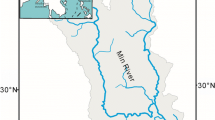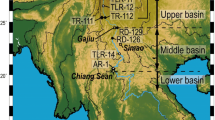Abstract
Chemical weathering of continental silicates significantly influences global climate change, earth surface processes, material cycling and oceanic chemical composition. How to quantitatively reconstruct chemical weathering history has become an important issue in global change research. Chemical index of alteration (CIA) has been widely used as a quantitative indicator for estimating the degree of silicate weathering. However, its method of calculation and the limitations of its application are not well understood. In this study, we calculated CIA values from suspended particulate matter collected from the mainstream and major tributaries of the Changjiang River. The values yielded considerable variations at different temporal and spatial scales. The average CIA values increased from the upper to middle-lower reaches, and were lower in the suspended samples taken during the flood than in the dry season. The spatial variation in the CIA is predominantly controlled by basinal monsoon climate. In contrast, the temporal variation in the Changjiang River basin is controlled mainly by the changing provenance of suspended samples in relation to the shift of the precipitation zone. The CIA probably indicates the integrated weathering history in the river basin, and thus, cannot be used as a reliable proxy of instantaneous chemical weathering. Furthermore, the calculation method and hydrodynamic sorting also influence the CIA values. Therefore, caution should be taken when using the CIA as a proxy for studying chemical weathering from different regions.
Article PDF
Similar content being viewed by others
Avoid common mistakes on your manuscript.
References
Raymo M E, Ruddiman W, Froelich P N. Influence of late Cenozoic mountain building on ocean geochemical cycles. Geology, 1988, 16: 649–653
Berner R A, Lasaga A C, Garrels R M. The carbonate-silicate geochemical cycle and its effect on atmospheric carbon dioxide over the past 100 million years. Am J Sci, 1983, 283: 641–683
Raymo M E, Ruddiman W F. Tectonic forcing of late Cenozoic climate. Nature, 1992, 359: 117–122
Krishnaswami S, Trivedi J R, Sarin M M, et al. Strontium isotopes and rubidium in the Ganges Brahmaputra river system weathering in the Himalaya, fluxes to the Bay of Bengal and contribution to the evolution of oceanic Sr87/Sr86. Earth Planet Sci Lett, 1992, 109: 243–253
Suchet P A, Probst J L. Modeling of atmospheric CO2 consumption by chemical weathering of rocks: Application to the Garonne, Congo and Amazon basins. Chem Geol, 1993, 107: 205–210
Kump L R, Brantley S L, Arthur M A. Chemical weathering, atmospheric CO2, and climate. Annu Rev Earth Planet Sci, 2000, 28: 611–667
Pierson-Wickmann A C, Reisberg L, France-Lanord C, et al. Os-Sr-Nd results from sediments in the Bay of Bengal: Implication for sediment transport and the marine Os record. Paleoceanography, 2001, 16: 435–444
Short N M. Geochemical variation in four residual soils. J Geol, 1961, 69: 534–571
Nesbitt H W, Young G M. Early Proterozoic climate and plate motion inferred from major element chemistry of lutites. Nature, 1982, 299: 715–717
Harnois L. The CIW index: A new chemical index of weathering. Sediment Geol, 1988, 55: 319–322
Sueoka T. Identification and classification of granitic residual soils using chemical weathering index. In: Proceedings of the Second International Conference on Geomechanics in Tropical Soils, Singapore. 1988, 1: 55–61
Fedo C M, Nesbitt H W, Young G M. Unraveling the effects of potassium metasomatism in sedimentary rocks and paleosols, with implications for paleo-weathering conditions and provenance. Geology, 1995, 23: 921–924
Gaillardet J, Dupre B, Allegre C J. Geochemistry of large river suspended sediments: Silicate weathering or recycling tracer. Geochim Cosmochim Acta, 1999, 63: 4037–4051
Duzgoren-Aydin N S, Aydin A. Indices for scaling and predicting weathering-induced changes in rock properties. Environ Eng Geosci, 2002, 2: 121–135
Price J R, Velbel M A. Chemical weathering indices applied to weathering profiles developed on heterogeneous felsic metamorphic parent rocks. Chem Geol, 2003, 202: 397–416
Ohta T, Arai H. Statistical empirical index of chemical weathering in igneous rocks: A new tool for evaluating the degree of weathering. Chem Geol, 2007, 240: 280–297
Roddaz M, Viers J, Brusset S, et al. Controls on weathering and provenance in the Amazonian foreland basin: Insights from major and trace element geochemistry of Neogene Amazonian sediments. Chem Geol, 2006, 226: 31–65
Vital H, Stattegger K. Major and trace elements of stream sediments from the lowermost Amazon River. Chem Geol, 2000, 168: 151–168
Yang S Y, Jung H S, Li C X. Two unique weathering regimes in the Changjiang and Huanghe drainage basins: Geochemical evidence from river sediments. Sediment Geol, 2004, 164: 19–34
Li C, Yang S Y. Is chemical index of alteration a reliable proxy for chemical weathering in global drainage basins? Am J Sci, 2010, 310: 111–127
Ahmad T, Khanna P P, Chakrapani G J, et al. Geochemical characteristics of water and sediment of the Indus River, Trans-Himalaya, India: Constraints on weathering and erosion. J Asian Earth Sci, 1998, 16: 333–346
Singh M, Sharma M, Tobschall H J. Weathering of the Ganga alluvial plain, northern India: Implications from fluvial geochemistry of the Gomati River. Appl Geochem, 2005, 20: 1–21
Tripathi J K, Ghazanfari P, Rajamani V, et al. Geochemistry of sediments of the Ganges alluvial plains: Evidence of large-scale sediment recycling. Quatern Int, 2007, 159: 119–130
Borges J, Huh Y, Moon S, et al. Provenance and weathering control on river bed sediments of the eastern Tibetan Plateau and the Russian Far East. Chem Geol, 2008, 254: 52–72
Liu Z, Zhao Y L, Colin C, et al. Chemical weathering in Luzon, Philippines from clay mineralogy and major-element geochemistry of river sediments. Geochemical, 2009, 24: 2195–2205
Selvaraj K, Chen T A. Moderate Chemical Weathering of Subtropical Taiwan: Constraints from Solid-Phase Geochemistry of Sediments and Sedimentary Rocks. J Geol, 2006, 114: 101–116
Qiao Y S, Zhao Z Z, Wang Y, et al. Variations of geochemical compositions and the paleoclimatic significance of a loess-soil sequence from Garzê County of western Sichuan Province, China. Chin Sci Bull, 2010, 55: 255–260
Yao Z Q, Xiao G Q, Liang M Y. BZ_2 drilling sediment’s geochemical composition of major element and chemical weathering in China North Plain. Chin Sci Bull, 2009, 54: 3400–3403
McLennan S M. Weathering and global denudation. J Geol, 1993, 101: 295–303
Yang S Y, Li C X. Elemental composition in the sediments of the Yangtze and the Yellow Rivers and their tracing implication. Prog Nat Sci, 2000, 10: 612–618
Kautz C Q, Martin C E. Chemical and physical weathering in New Zealand’s Southern Alps monitored by bedload sediment major element composition. Appl Geochem, 2007, 22: 1715–1735
Nesbitt H W, Young G M. Prediction of some weathering trends of plutonic and volcanic rocks based on thermodynamic and kinetic considerations. Geochim Cosmochim Acta, 1984, 48: 1523–1534
Nesbitt H W, Young G M. Formation and diagenesis of weathering profiles. J Geol, 1989, 97: 129–147
Chen J, Wang H T, Lu H Y. Behaviors of REE and other trace elements during pedological weathering-Evidence from chemical leaching of loess and paleosol from the Luochuan section in central China (in Chinese). Acta Geol Sin, 1996, 70: 61–72
Song Y H, Choi M S. REE geochemistry of fine-grained sediments from major rivers around the Yellow Sea. Chem Geol, 2009, 266: 328–342
Mao C P, Chen J, Yuan X, et al. Seasonal variation the mineralogy of the suspended particulate matter of the lower Changjiang River at Nanjing, China. Clays Clay Miner, 2010, 58: 691–706
Viers J, Dupre B, Gaillardet J. Chemical composition of suspended sediments in World River: New insights from a new database. Sci Total Environ, 2008, 407: 853–868
Yang S L, Zhao Q Y, Belkin I M. Temporal variation in the sediment load of the Yangtze River and the influences of human activities. J Hydrol, 2002, 263: 56–71
Wang Z Y, Huang W D, Li Y T. Sediment budget of the Yangtze River (in Chinese). J Sed Res, 2007, 2: 1–10
Potter P E, Maynard J B, Depetris P J. Mud and Mudstones. Berlin: Springer, 2005. 157–174
Chen Z, Gupta A, Yin H F. Monsoon rivers of Asia. Geomorphology, 2007, 85: 129–130
Chen J S. Principle of River Water Quality in China (in Chinese). Beijing: Science Press, 2006. 103–126
Chen Z Y, Wang Z H, Finlayson B, et al. Implication of flow control by the Three Gorges Dam on sediment and channel dynamics of the middle Yangtze (Changjiang) River, China. Geol Soci Am, 2010, 38: 1043–1046
Johnsson M J, Meade R H. Chemical weathering of fluvial sediments during alluvial storage: The Macupanim Island point bar, Solimoes River, Brazil. J Sediment Petrol, 1990, 60: 827–842
Derry L A, France-Lanord C. Neogene Himalayan weathering history and river 87Sr/86Sr: Impact on the marine Sr record. Earth Planet Sci Lett, 1996, 142: 59–76
Heller P L, Peter E B, Humphrey N F, et al. Paradox of downstream fining and weathering-rind formation in the lower Hoh River, Olympic Peninsula, Washington. Geology, 29: 971–974
Mao C P. Geochemical and mineralogical studies of the sediment (suspended sediment) in Changjiang River Drainage Basin (in Chinese). Dissertation for the Doctoral Degree. Nanjing: Nanjing University, 2009
Tang J J. The temporal and spatial distribution of precipitation over Yangtze River Catchment from 1952 to 2007—Case study of precipitation redistribution under global warming (in Chinese). Dissertation for the Master’s Degree. Shanghai: East China Normal University, 2010
Dai S B, Yang S L, Zhao H Y, et al. Response of middle and lower reaches of Yangtze River to the initial operation stage of the Three Gorges Project (in Chinese). J Sediment Res, 2005, 5: 35–39
Xu B K, Milliman J D, Yang Z, et al. Yangtze sediment decline partly from Three Gorges Dam. EOS, 2006, 87: 185–196
Yang Z, Wang H, Saito Y, et al. Dam impacts on the Changjiang (Yangtze) River sediment discharge to the sea: The past 55 years and after the Three Gorges Dam. Water Resour Res, 2006, 42: 1–10
Author information
Authors and Affiliations
Corresponding author
Additional information
This article is published with open access at Springerlink.com
Rights and permissions
This article is published under an open access license. Please check the 'Copyright Information' section either on this page or in the PDF for details of this license and what re-use is permitted. If your intended use exceeds what is permitted by the license or if you are unable to locate the licence and re-use information, please contact the Rights and Permissions team.
About this article
Cite this article
Shao, J., Yang, S. Does chemical index of alteration (CIA) reflect silicate weathering and monsoonal climate in the Changjiang River basin?. Chin. Sci. Bull. 57, 1178–1187 (2012). https://doi.org/10.1007/s11434-011-4954-5
Received:
Accepted:
Published:
Issue Date:
DOI: https://doi.org/10.1007/s11434-011-4954-5




